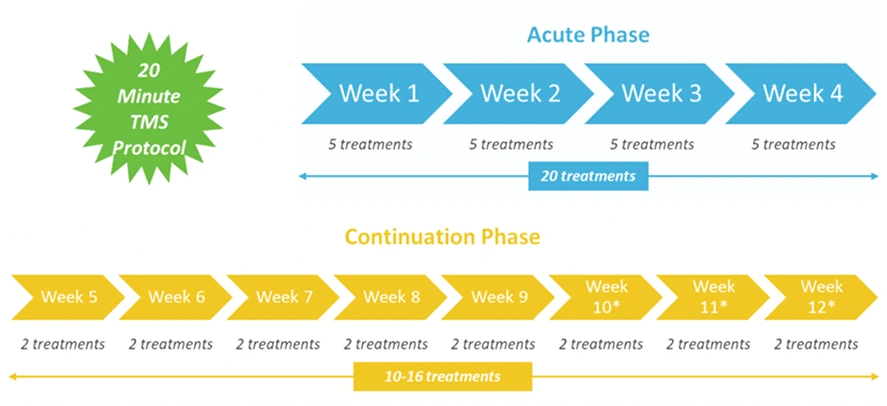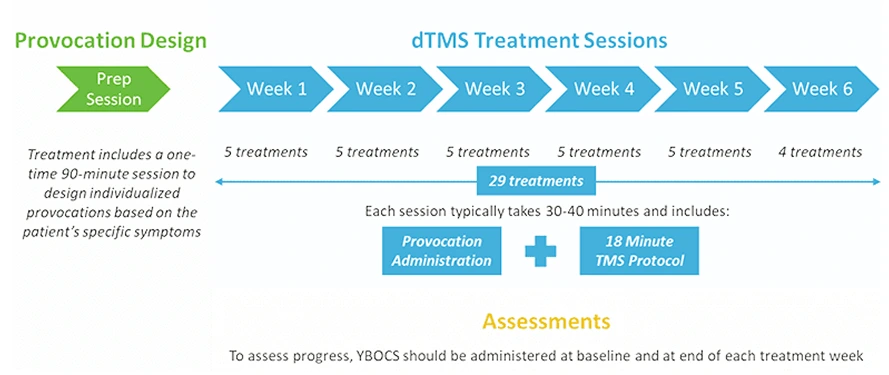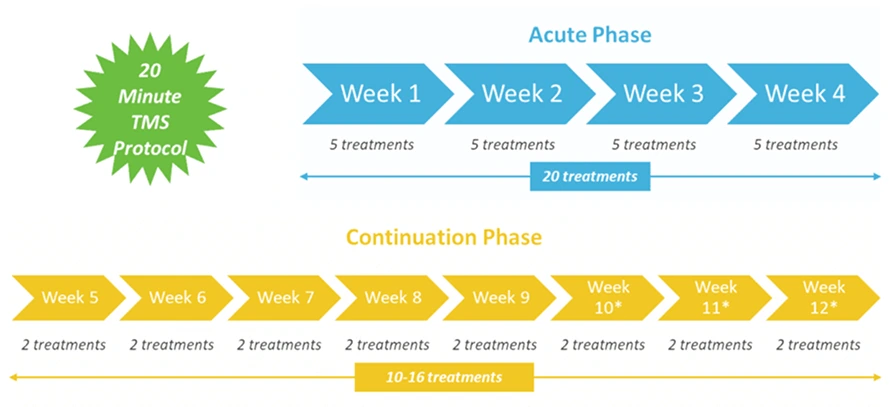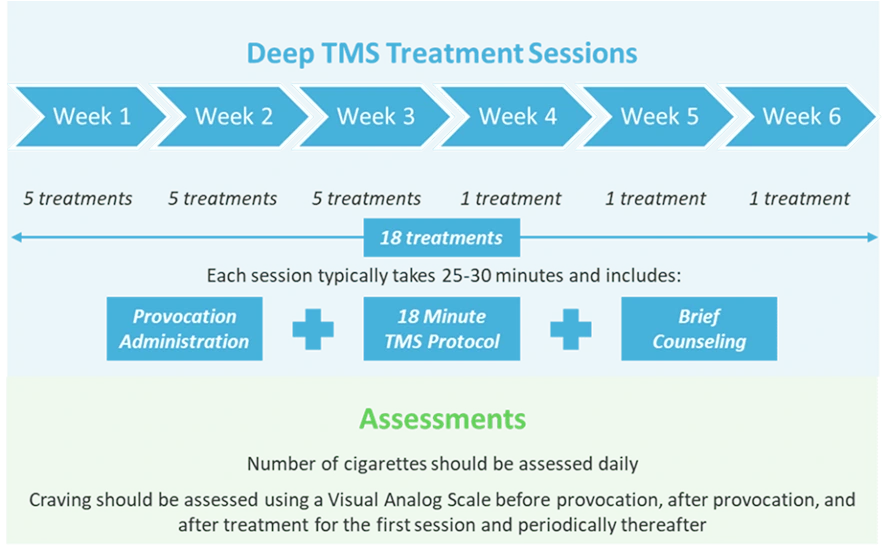For patients with major depression, standard rTMS protocols typically involve 20-30 sessions administered over 4-6 weeks. Procedures are performed 5 days a week (usually Monday through Friday), each lasting approximately 20-40 minutes. This consistent schedule helps gradually modulate neural activity in regions associated with the disorder. Research indicates that some patients may begin noticing improvements in their depression symptoms after several sessions. However, the full therapeutic effect often develops throughout the treatment course. Maintenance sessions may be recommended following the initial therapy period, with frequency determined by individual response and relapse risk.
When treating OCD, rTMS therapy typically follows a similar timeframe to depression protocols, with 20-30 sessions over 4-6 weeks. However, the targeting differs, focusing on brain regions like the supplementary motor area or orbitofrontal cortex. Each session lasts 30-40 minutes, and patients undergo daily treatments five times weekly. For OCD, some protocols employ higher frequencies or more intense stimulation parameters, which doesn’t necessarily extend procedure duration but may enhance efficacy. Patient response to rTMS therapy can vary, with many individuals requiring an entire course before experiencing significant symptom reduction.
For various anxiety disorders, rTMS treatments generally span 4-6 weeks with 20-30 sessions delivered on a daily weekday schedule. Each procedure typically lasts 20-40 minutes, depending on the specific protocol. Unlike some other mental disorders, anxiety often requires particular attention to patient comfort during initial sessions, as the sensation of magnetic pulses may temporarily increase feelings of worry in sensitive individuals. Researchers and clinicians continue to refine protocols to optimally treat symptoms of generalized anxiety, panic disorder, and social anxiety, with some evidence suggesting that longer courses (up to 8 weeks) might benefit patients with more severe or treatment-resistant conditions.
In the emerging field of addiction treatment, rTMS protocols typically range from 10-15 sessions for shorter courses to 20-30 sessions for more comprehensive interventions, administered over 2-6 weeks. Daily sessions lasting 20-30 minutes target brain regions associated with craving and reward circuitry, particularly the dorsolateral prefrontal cortex. The duration may vary based on the substance involved, with alcohol and nicotine addiction protocols being more established than those for other substances. Some treatment programs implement accelerated schedules with multiple daily sessions over a shorter period. This may be particularly beneficial for patients requiring intensive intervention while maintaining the same number of pulses delivered across the therapy course.
Deep TMS therapy for MDD follows a structured protocol consisting of two distinct phases. The acute stage includes 20 treatments administered over 4 weeks (5 sessions per week), with each procedure lasting approximately 20 minutes. This is followed by a continuation phase of 10-16 additional procedures distributed over weeks 5-12, with visits becoming less frequent. This tapering approach helps patients with treatment-resistant depression maintain improvements while transitioning to less intensive care. The H-coil stimulates deeper brain structures than conventional rTMS, potentially providing more comprehensive coverage of mood-regulating neural networks.

For OCD, dTMS involves a specific protocol of 29 treatments delivered over 6 weeks. Each session consists of procedures lasting 30 to 40 minutes with a symptom provocation followed by an 18-minute TMS therapy. Patients are briefly exposed to customized triggers that activate OCD circuits, immediately followed by magnetic stimulation targeted at the anterior cingulate cortex and medial prefrontal regions. Providers maintain a consistent five-day-per-week schedule throughout the course, with the last week having 4 TMS treatment sessions. This standardized approach has received FDA clearance for OCD resistant to conventional techniques.

Deep TMS for anxious depression follows the same fundamental structure as the MDD protocol, with 20-minute procedures delivered in two phases. The acute stage consists of 20 treatments over 4 weeks (daily weekday sessions), followed by a continuation period of 10-16 sessions distributed across weeks 5-12. This approach allows clinicians to stimulate nerve cells in regions implicated in both anxiety and depression symptoms. The continuation phase gradually decreases procedure frequency. This extended protocol helps stabilize mood improvements while addressing the often-intertwined nature of anxiety and depressive symptoms.

Deep TMS protocols for smoking cessation consist of 18 treatments delivered over 6 weeks, with sessions concentrated more heavily in the early period. Each session lasts 25-30 minutes and includes three components: a brief smoking provocation (exposure to smoking-related cues), the TMS procedure itself, and a short counseling intervention. The schedule features more frequent visits during weeks 1-3. The provocation component activates nicotine craving circuits immediately before stimulation, enhancing the treatment’s effectiveness. This integrated approach combines neurophysiological intervention with behavioral support to address both the neural and psychological aspects of nicotine addiction. There are also sophisticated protocols for other types of substance use, including alcohol and cocaine.

TBS offers a significantly condensed timeline for depression treatment compared to conventional rTMS protocols. A standard iTBS therapy consists of shorter sessions lasting just 3-10 minutes each, delivered with 50-minute pauses 10 times daily for 5 days. This dramatic reduction in procedure duration makes treatment more accessible for patients with severe depression who may struggle with longer appointments. There are also other TBS protocols, potentially achieving similar outcomes in several weeks. Maintenance sessions may follow monthly, though approaches vary based on individual response and relapse risk factors.
For OCD, TBS protocols typically include 20-50 sessions delivered over 1-6 weeks, with each procedure lasting only 3-10 minutes — dramatically shorter than conventional rTMS or dTMS interventions. Some techniques utilize continuous theta burst stimulation (cTBS) to target hyperactive brain regions, while others use intermittent TBS to enhance activity in specific regions. Our practice shows that targeting the supplementary motor area or orbitofrontal cortex with TBS may produce treatment outcomes comparable to those of more extended traditional protocols while significantly reducing the time commitment.
TBS for anxiety disorders generally follows a 2-4 week treatment course with daily sessions lasting just 3-10 minutes each. This remarkably brief duration represents a significant advantage for patients with anxiety who may find more prolonged procedures challenging to tolerate. Standard protocols include 10-20 sessions, though some clinics offer intensive formats with multiple daily sessions over 5-10 days. TBS targets the same brain regions as conventional rTMS for anxiety (typically the dorsolateral prefrontal cortex), but delivers stimulation in bursts that more closely mimic natural brain rhythms.
In addiction treatment, TBS protocols typically involve 10-50 sessions delivered over 2-3 weeks, with each lasting only 3-10 minutes. This condensed format allows for more flexible scheduling while delivering comparable total pulses to more prolonged conventional procedures. Some emerging protocols implement multiple daily TBS sessions (5-10 per day) over one week as an intensive intervention for acute addiction treatment. As with other techniques, this therapy targets the dorsolateral prefrontal cortex to enhance cognitive control mechanisms. However, the optimal parameters and duration continue to evolve as research progresses in this relatively newer application of TMS technology.
Procedure
Mindset TMS is one of the leading providers of TMS in Northern Colorado, offering comprehensive care in a state-of-the-art facility. Our experienced providers determine how many TMS treatments are needed during the initial consultation and develop personalized plans based on the specific condition and response to therapy. We offer all primary TMS modalities including standard rTMS, Deep TMS, and innovative TBS protocols, providing patients with options that fit their clinical needs and lifestyle demands. Mindset TMS distinguishes itself through comprehensive support throughout the treatment journey, from initial insurance verification to post-treatment follow-up care. With convenient scheduling options including early morning and evening appointments, we accommodate working professionals while maintaining the consistent therapy schedule necessary for optimal outcomes.
Understanding how many TMS sessions your treatment will require depends on your specific condition, the TMS protocol used, and your response to therapy. While standard protocols provide general guidelines, leading TMS clinics customize treatment durations based on clinical assessment and ongoing progress evaluation. Most patients can expect to commit to several weeks of consistent treatment to achieve optimal results, with potential maintenance sessions following the initial course. Discussing your schedule constraints and treatment expectations with your provider before beginning therapy will help ensure you can fully commit to the recommended protocol and maximize your chances of successful symptom relief.
Do not hesitate to schedule a consultation today and experience the transformative effects of TMS. This treatment is safer than electroconvulsive therapy and many other forms of brain stimulation. Mindset TMS can offer the best conditions to achieve significant results with maximum comfort and convenience.